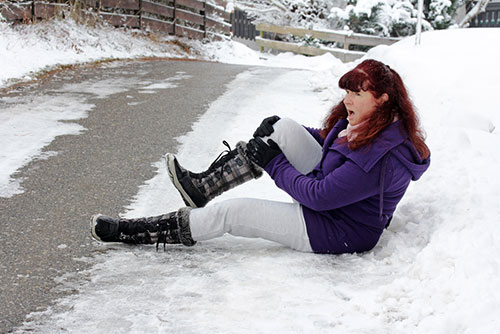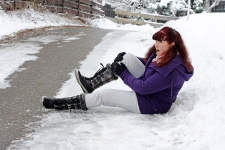
With snow and ice, comes slips and falls. Unfortunately, slipping on ice can lead to many injuries and visits to the doctor. So, before you head outside this winter, it’s important to take some precautionary measures to ensure your safety. In this blog, we’ll talk about how to prevent slipping and falling on ice and what to do if you do.
Common Ice Slip Injuries
According to the CDC, one out of every five falls can lead to a serious injury like broken bones or a head injury. This means danger is lurking in the winter! The most common injuries when falling on ice are:
- Broken bones
- Muscle sprains and strains
- Fractures
- Back injuries
- Concussions and traumatic brain injuries
- Internal bruising and bleeding
How to Prevent Slipping on Ice
- Wear proper footwear – It’s not uncommon for there to be ice and snow on sidewalks and in parking lots in the winter, so prepare yourself by wearing the proper footwear like boots or slip-resistant shoes.
- Walk cautiously – Walk slowly, take small steps, and watching where you’re going. Be aware as you could walk onto black ice, which appears to be a wet surface but is actually solid ice. If you get stuck on an icy patch, take small steps and shuffle your feet. Before walking, you can test out your path by sliding your shoe before you to see if the surface is slick.
- Use your arms – Keep your hands out of your pockets and your arms at your side. Having your arms out will help keep you balanced if you walk into a slick spot. With that in mind, don’t carry a large load in your hands, but instead, wear a backpack or purse to store your belongings.
- Be alert when exiting a car – Be careful when exiting a car as you never know what’s on the other side of the door. Slowly and firmly place your feet on the ground and use your car for extra support.
- Use handrails – Floors and steps can get slick rather quickly, so be cautious and use the handrails whenever you can. Out of caution, always wipe your feet on rugs before you enter a building.
- Shovel snow immediately – Before the snow gets packed down and turns to ice, shovel your sidewalks and driveways as soon as possible. Once you have it cleared, throw down some ice melt to prevent ice from forming.
- Fall like a professional – If you feel yourself going down, tuck in your chin, bend your limbs, and try to land on your side to better prevent an injury.
What to Do If You Slip on Ice
If you slip on ice, don’t pretend to be okay if you are actually hurt. It can be embarrassing, but it can also be incredibly painful and serious. If you fall on ice and are in pain, you should do the following:
- Seek medical attention – Whether you hurt your arm or bumped your head, it’s very important to seek medical attention if you feel any pain. If not addressed quickly, some of these injuries can become worse and be quite costly. Swelling and bruising are definite indicators of injury to the area. However, the only way to know for sure if a break has occurred is via x-ray, which is why it’s important to have your injury evaluated as soon as possible. If you’re not able to see a doctor right away, make sure to follow the RICE treatment protocol, which stands for: Rest (get off your feet), Ice (apply ice to the injured area for 20 minutes every hour), Compression (such as an ACE bandage to help reduce swelling), and Elevation (keep your foot above your heart).
- Record details – If you believe your slip and fall was caused by negligence, you may need to file for compensation. In this instance, you should: record witnesses, take photos, report to the owner, and call an attorney.
Closing Thoughts
If you happen to injure yourself while falling on the ice this winter, please don’t hesitate to give us a call. Our qualified providers here at Prairie Orthopaedic and Plastic Surgery, PC would be more than happy to evaluate and treat your injury to get you back on your feet again! To schedule an appointment, please call 402-489-4700.

